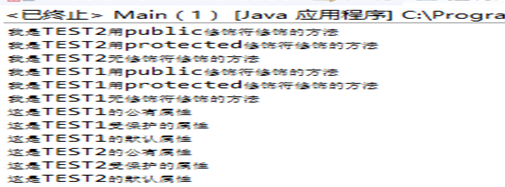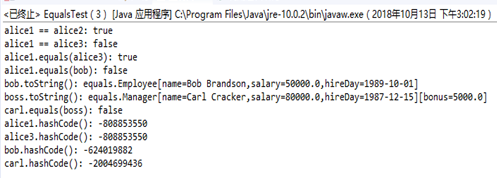一、理论知识部分
访问修饰符:private:只有该类可以访问 protected:该类及其子类的成员可以访问,同一个包中的类也可访问 public:该类或非该类均可访问 默认:相同包中的类可以访问
注:不写访问修饰符时默认为friendly
Object类是Java中所有类的祖先——每一个类都由它扩展而来。在不给出超类的情况下,Java会自动把Object 作为要定义类的超类。可以使用类型为Object的变量指向任意类型的对象。但要对它们进行专门的操作都要进行类型转换。
Object类中的equals方法用于测试某个对象是否同另一个对象相等。它在Object类中的实现是判断两个对象是否具有相同的引用。如果两个对象具有相同的引用,它们一定是相等的。
Object类中的hashCode方法导出某个对象的散列码。散列码是任意整数,表示对象的存储地址。两个相等对象的散列码相等。
Object类的toString方法返回一个代表该对象域值的字符串。toString方法返回字符串的格式:类名,然后在方括号中列举域值。通过 getClass().getName()获得类名的字符串。
toString的调用方式:一个字符串与对象名通过操作符“+”连接起来,就会自动调用toString方法。 String message = “The current employee is”+x;
如果x是任意一个对象,调用System.out.println(x),就会直接地调用x.toString(),并打印输出字符串。
定义子类的toString方法时,可先调用超类的toString方法。super.toString( )
Java中,利用ArrayList类,可允许程序在运行时确定数组的大小。ArryList是一个采用类型参数的泛型类。为指定数组列表保存元素的对象类型,需要用一对尖括号将数组元素对象类名括起来加在后面。 ArryList staff=new ArrayList();
没有<>的ArrayList将被认为是一个删去了类型参数的“原始”类型。
所有基本数据类型都有着与之对应的预定义类,它们被称为对象包装器(wrapper)。对象包装器类是不可变的,即一旦构造了包装器,就不允许更改包装在其中的值。且对象包装器类还是final,因此不能定义它们的子类。
使用对象包装器的好处:基本类型转化为对象;定义一些有用的基本方法(static方法)。
声明枚举类 public enum Grade { A, B, C, D, E };
它包括一个关键字enum,一个新枚举类型的名字 Grade以及为Grade定义的一组值,这里的值既非整型,亦非字符型。
枚举类说明:枚举类是一个类,它的隐含超类是java.lang.Enum。枚举值并不是整数或其它类型,是被声明的枚举类的自身实例。枚举类不能有public修饰的构造函数,构造函数都是 隐含private,编译器自动处理。枚举值隐含都是由public、static、final修饰的,无须自己添加这些修饰符。在比较两个枚举类型的值时,永远不需要调用 equals 方法,直接使用"=="进行相等比较。
二、实验部分
1、实验目的与要求
(1)进一步理解4个成员访问权限修饰符的用途;
(2)掌握Object类的常用API用法;
(3)掌握ArrayList类用法与常用API;
(4)掌握枚举类使用方法;
(5)结合本章知识,理解继承与多态性两个面向对象
程序设计特征,并体会其优点;
(6)熟练掌握Java语言中基于类、继承技术构造程序的语法知识(ch1-ch5);
(7)利用已掌握Java语言程序设计知识,学习设计开发含有1个主类、2个以上用户自定义类的应用程序。
2、实验内容和步骤
实验1 补充以下程序中主类内main方法体,以验证四种权限修饰符的用法。
|
public class TEST1 { private String t1 = "这是TEST1的私有属性"; public String t2 = "这是TEST1的公有属性"; protected String t3 = "这是TEST1受保护的属性"; String t4 = "这是TEST1的默认属性"; private void tese1() { System.out.println("我是TEST1用private修饰符修饰的方法"); } public void tese2() { System.out.println("我是TEST1用public修饰符修饰的方法"); } protected void tese3() { System.out.println("我是TEST1用protected修饰符修饰的方法"); } void tese4() { System.out.println("我是TEST1无修饰符修饰的方法"); } } public class TEST2 extends TEST1{ private String e1 = "这是TEST2的私有属性"; public String e2 = "这是TEST2的公有属性"; protected String e3 = "这是TEST2受保护的属性"; String e4 = "这是TEST2的默认属性"; public void demo1() { System.out.println("我是TEST2用public修饰符修饰的方法"); } private void demo2() { System.out.println("我是TEST2用private修饰符修饰的方法"); } protected void demo3() { System.out.println("我是TEST2用protected修饰符修饰的方法"); } void demo4() { System.out.println("我是TEST2无修饰符修饰的方法"); } } public class Main { public static void main(String[] args) { TEST2 test2 = new TEST2(); /*以下设计代码分别调用 demo1 demo2 demo3 demo4 test1 test2 test3 test4方法和t1 t2 t3 t3 e1 e2 e3 e4属性,结合程序运行结果理解继承和权限修饰符的用法与区别*/ } } |
public class TEST1 { private String t1 = "这是TEST1的私有属性"; public String t2 = "这是TEST1的公有属性"; protected String t3 = "这是TEST1受保护的属性"; String t4 = "这是TEST1的默认属性"; private void test1() { System.out.println("我是TEST1用private修饰符修饰的方法"); } public void test2() { System.out.println("我是TEST1用public修饰符修饰的方法"); } protected void test3() { System.out.println("我是TEST1用protected修饰符修饰的方法"); } void test4() { System.out.println("我是TEST1无修饰符修饰的方法"); } } public class TEST2 extends TEST1{ private String e1 = "这是TEST2的私有属性"; public String e2 = "这是TEST2的公有属性"; protected String e3 = "这是TEST2受保护的属性"; String e4 = "这是TEST2的默认属性"; public void demo1() { System.out.println("我是TEST2用public修饰符修饰的方法"); } private void demo2() { System.out.println("我是TEST2用private修饰符修饰的方法"); } protected void demo3() { System.out.println("我是TEST2用protected修饰符修饰的方法"); } void demo4() { System.out.println("我是TEST2无修饰符修饰的方法"); } } public class Main { public static void main(String[] args) { TEST2 test2 = new TEST2(); /*在下面分别调用 demo1 demo2 demo3 demo4 test1 test2 test3 test4方法 和 t1 t2 t3 t4 e1 e2 e3 e4属性,好好理解继承和权限修饰符的用法与区别*/ //demo2 test1 t1 e1是用private修饰符修饰的,不能被访问 test2.demo1(); test2.demo3(); test2.demo4(); test2.test2(); test2.test3(); test2.test4(); System.out.println(test2.t2); System.out.println(test2.t3); System.out.println(test2.t4); System.out.println(test2.e2); System.out.println(test2.e3); System.out.println(test2.e4); } }

实验2 第五章测试程序反思,继承知识总结。
测试程序1:
编辑、编译、调试运行教材程序5-8、5-9、5-10(教材174页-177页);
结合程序运行结果,理解程序代码,掌握Object类的定义及用法;
package equals; /** * This program demonstrates the equals method. * @version 1.12 2012-01-26 * @author Cay Horstmann */ public class EqualsTest { public static void main(String[] args) { Employee alice1 = new Employee("Alice Adams", 75000, 1987, 12, 15); Employee alice2 = alice1; Employee alice3 = new Employee("Alice Adams", 75000, 1987, 12, 15); Employee bob = new Employee("Bob Brandson", 50000, 1989, 10, 1); System.out.println("alice1 == alice2: " + (alice1 == alice2)); System.out.println("alice1 == alice3: " + (alice1 == alice3)); System.out.println("alice1.equals(alice3): " + alice1.equals(alice3)); System.out.println("alice1.equals(bob): " + alice1.equals(bob)); System.out.println("bob.toString(): " + bob); Manager carl = new Manager("Carl Cracker", 80000, 1987, 12, 15); Manager boss = new Manager("Carl Cracker", 80000, 1987, 12, 15); boss.setBonus(5000); System.out.println("boss.toString(): " + boss); System.out.println("carl.equals(boss): " + carl.equals(boss)); System.out.println("alice1.hashCode(): " + alice1.hashCode()); System.out.println("alice3.hashCode(): " + alice3.hashCode()); System.out.println("bob.hashCode(): " + bob.hashCode()); System.out.println("carl.hashCode(): " + carl.hashCode()); } }
package equals; import java.time.*; import java.util.Objects; public class Employee { private String name; private double salary; private LocalDate hireDay; public Employee(String name, double salary, int year, int month, int day) { this.name = name; this.salary = salary; hireDay = LocalDate.of(year, month, day); } public String getName() { return name; } public double getSalary() { return salary; } public LocalDate getHireDay() { return hireDay; } public void raiseSalary(double byPercent) { double raise = salary * byPercent / 100; salary += raise; } public boolean equals(Object otherObject) { // 快速测试以确定对象是否相同 if (this == otherObject) return true;//检测this与otherObject是否引用同一个对象 // 如果显示参数为null,则返回false if (otherObject == null) return false;//检测otherObject是否为null,如果为null,返回false //如果类不匹配,他们不可能相等 if (getClass() != otherObject.getClass()) return false;//比较this与otherObject是否属于同一个类。如果equals的语义在每个子类中有所改变,就使用getClass检测 // 现在我们知道其他的对象是一个非空Employee Employee other = (Employee) otherObject;//将otherObject转换为相应的类类型变量 // 检测是否有相同的值 return Objects.equals(name, other.name) && salary == other.salary && Objects.equals(hireDay, other.hireDay);//Objects.quals方法防备参数可能为null的情况 } public int hashCode() { return Objects.hash(name, salary, hireDay); } //Employee类中的toString方法的实现。通过调用getClass().getName()获得类名的字符串 public String toString() { return getClass().getName() + "[name=" + name + ",salary=" + salary + ",hireDay=" + hireDay + "]"; } }
package equals; public class Manager extends Employee { private double bonus; public Manager(String name, double salary, int year, int month, int day) { super(name, salary, year, month, day); bonus = 0; } public double getSalary() { double baseSalary = super.getSalary(); return baseSalary + bonus; } public void setBonus(double bonus) { this.bonus = bonus; } //调用超类的equals public boolean equals(Object otherObject) { if (!super.equals(otherObject)) return false; Manager other = (Manager) otherObject; // super.equals检查这个和其他属于同一个类 return bonus == other.bonus; } public int hashCode() { return java.util.Objects.hash(super.hashCode(), bonus); } //toString方法也可以供子类调用 public String toString() { return super.toString() + "[bonus=" + bonus + "]";// } }

测试程序2:
编辑、编译、调试运行教材程序5-11(教材182页);
结合程序运行结果,理解程序代码,掌握ArrayList类的定义及用法;
package arrayList; import java.util.*; /** * This program demonstrates the ArrayList class. * @version 1.11 2012-01-26 * @author Cay Horstmann */ public class ArrayListTest { public static void main(String[] args) { //用三个雇员Employee对象ArrayList填充人员数组列表<Employee> ArrayList<Employee> staff = new ArrayList<>();//构造和声明一个保存Employee对象的数组列表。结合new操作符使用菱形语法,如果赋值给一个变量,或传递到某种方法,
或者从某个方法返回,编译器会检查这个变量、参数或方法的泛型类型,然后将这个类型放在<>中。 //使用add方法将雇员对象添加到数组列表中 staff.add(new Employee("Carl Cracker", 75000, 1987, 12, 15)); staff.add(new Employee("Harry Hacker", 50000, 1989, 10, 1)); staff.add(new Employee("Tony Tester", 40000, 1990, 3, 15)); // 提高每人5%的工资 for (Employee e : staff) e.raiseSalary(5); // 输出关于所有Employee对象的信息 for (Employee e : staff) System.out.println("name=" + e.getName() + ",salary=" + e.getSalary() + ",hireDay=" + e.getHireDay()); } }
package arrayList; import java.time.*; public class Employee { private String name; private double salary; private LocalDate hireDay; public Employee(String name, double salary, int year, int month, int day) { this.name = name; this.salary = salary; hireDay = LocalDate.of(year, month, day); } public String getName() { return name; } public double getSalary() { return salary; } public LocalDate getHireDay() { return hireDay; } public void raiseSalary(double byPercent) { double raise = salary * byPercent / 100; salary += raise; } }

测试程序3:
编辑、编译、调试运行程序5-12(教材189页);
结合运行结果,理解程序代码,掌握枚举类的定义及用法;
package enums; import java.util.*; /** * This program demonstrates enumerated types. * @version 1.0 2004-05-24 * @author Cay Horstmann */ public class EnumTest { public static void main(String[] args) { Scanner in = new Scanner(System.in); System.out.print("Enter a size: (SMALL, MEDIUM, LARGE, EXTRA_LARGE) "); String input = in.next().toUpperCase(); Size size = Enum.valueOf(Size.class, input); System.out.println("size=" + size); System.out.println("abbreviation=" + size.getAbbreviation()); if (size == Size.EXTRA_LARGE) System.out.println("Good job--you paid attention to the _."); } } //枚举类型 enum Size { SMALL("S"), MEDIUM("M"), LARGE("L"), EXTRA_LARGE("XL"); private Size(String abbreviation) { this.abbreviation = abbreviation; } public String getAbbreviation() { return abbreviation; } private String abbreviation; }

实验3:采用个人账号登录https://pintia.cn/,完成《2018秋季西北师范大学面向对象程序设计(Java)(ch1-ch5)测试题2》,测试时间60分钟;
实验4: 课后完成实验3未完成的测试内容。
三、实验总结:通过这次实验,我理解了4个成员访问权限修饰符的用途以及继承; 通过实验和课本知识的结合,更好的掌握了Object类的定义及用法、ArrayList类的定义及用法、枚举类的定义及用法。通过测试表明对之前知识掌握的不够好,编程仍需努力,之前忽略了课本知识,对一些理论知识掌握不够透彻,这些都需要学习。